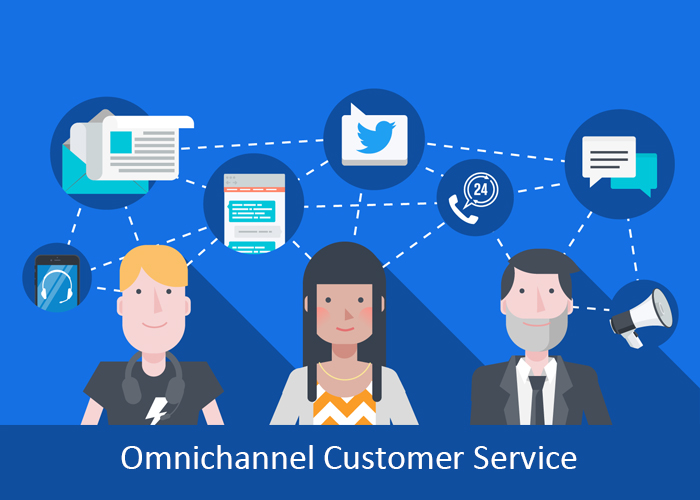Done well, omnichannel can provide a way to survive in today’s highly-saturated marketplace.
Technological advancements are becoming more embedded in our culture and affecting modern day interactions, increasing the importance of making sense of an omnichannel customer experience. In today’s interconnected world, omnichannel has become more than a buzzword; it’s a consistent, personalized journey that 75% of consumers expect today, according to the 2016 State of Connected Customer Report from Salesforce.
However, consumer demands continue to become increasingly hard to meet, which is leading many brands to make mistakes that create a weak omnichannel experience and erode customer loyalty. In fact, a recent DMG Consulting report revealed most organizations are lagging in the implementation of true omnichannel customer service.
To earn a position at the forefront of omnichannel evangelism, start the new year off by evaluating your customer service strategy and understanding these seven deadly blunders killing customer experiences.
- Inconsistency Across Customer Touchpoints
More than half of all consumers engage with companies on more than one channel to get a customer service-related issue resolved, according to a 2015 study by management consulting firm The Northridge Group. To better unify interactions with customers, companies not only should include multiple channels but also knit them together appropriately. Companies can accomplish this by interlacing channels into one single interface and transcribing all interactions, allowing agents to switch between channels more efficiently and not force customers to repeat information. - Failing to Leverage Artificial Intelligence (AI)
As AI matures, contact centers need to embrace it to stay innovative. AI can play a key role in customer support by anticipating a customer’s inquiry and predicting what he or she will ask. Each time a chatbot interacts with a human, it learns to recognize specific patterns and stores that data for future reference. Over time, chatbots begin to understand language, not just commands, allowing businesses to increase efficiency while gaining helpful market insights in the process. - Making All Channels Equal
Consumers want service on their terms with the minimal wait time. Waiting on standby or holding for an available agent can be frustrating, so mapping out important points of interaction for your business is vital and can speed up interactions. For instance, millennials are partial to companies that enable and excel at customer service via texting. Generation Z is just rising to power in consumer markets, and will likely have different preferences. By looking at your target audience and determining which channel it prefers, businesses can create tailor-made experiences for customers while enabling agents to resolve issues quickly, especially if those channels can be integrated with automated technology. - Under-Training Agents
Today’s demand for omnichannel perfection means that contact center agents must be skilled across multiple channels. However, contact centers are not implementing the necessary training to help agents deliver an easy, frictionless customer experience. In fact, only 30% of contact center decision-makers train all their agents to support multiple channels, according to a 2015 Forrester report. By training customer service teams to be well-versed in every digital channel, organizations can combat frequent discrepancies in service. - Not Seeking Vendor Support
Providing a consistent omnichannel experience is nearly impossible without vendor support. Great vendors can turn your pie-in-the-sky support strategy into a reality, allowing you to scale and shift cadence with customer demand. Vendors also are frequently well-versed in new trends and challenges and frequently roll out updates to support change and differentiation. Keep in mind, though, the right vendor will seek to learn your objectives and share ownership of them. A vendor that tries to force you into its methodology is a problem posing as a solution. - Lacking a Cross-channel Measurement Strategy
A measurement system to track the right key performance indicators is crucial to help fabricate better omnichannel strategies for the future and deliver a high-level customer experience. Once you’ve outlined benchmarks, use analytics built into your communications platform for easy reporting. The most successful companies use omnichannel insights to measure, report, analyze, and allocate resources as needed to ensure alignment of agents, technology, and operations. - Focusing on the Wrong Aspect of Omnichannel
Having the right channels in place and the appropriate support for those channels is key for omnichannel solutions. However, the most important aspect of the word “omnichannel” isn’t “channel” but “omni” — you mustn’t begin with the channel, but with the customer. This means offering assistance in any way your customer might be trying to find it rather than not trying to funnel your customer down the channel you think is best. Don’t fall into a sales tactic trap: The more channels a vendor is able to sell, the more it can charge for features. This is not a bad business model, but it’s out of line with the spirit of omnichannel. Selling more features is about the vendor, not the overall business, and certainly not the customer. Think about the customers, their needs, and their preferences first. This should guide your entire solution. Then use technology to bridge the gap between your customers and your business processes.
Omnichannel Software
A Retail Management System streamlines separate sales channels to provide seamless shopping experiences anytime, anywhere.
Moving Forward
Omnichannel is no longer just a CRM initiative, but a way to ensure survival in today’s highly-saturated marketplace. As Gartner reports have shown, companies are now expected to compete mainly on customer experience. That makes the ability to deliver consistent communications vital to maintain the competitive advantage. Help drive your brand in the right direction this year by implementing omnichannel strategies that meet the needs of today’s consumers and integrate the latest technologies across all touchpoints.
The original content was published by Murph Krajewski on www.nojitter.com!
Related Posts:
– A Prediction of Omnichannel Trends in 2018
– Top 25 Omnichannel Retailers and What to learn from them




